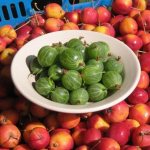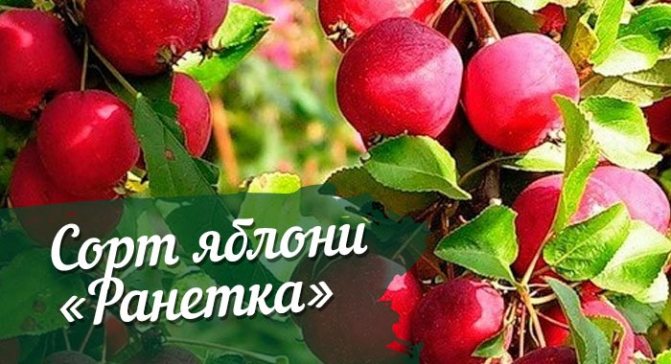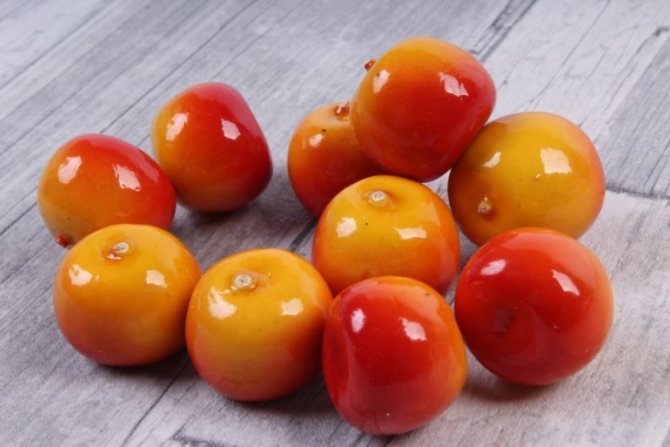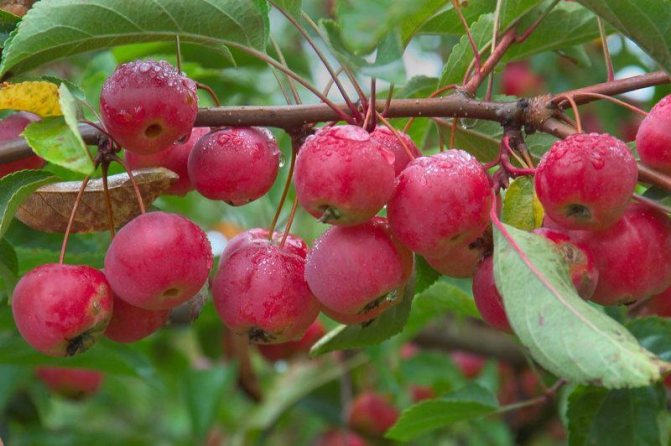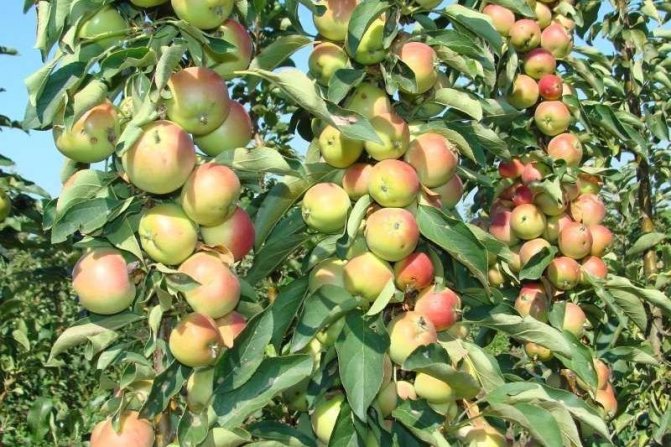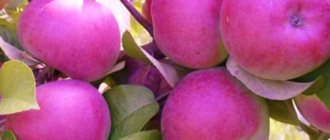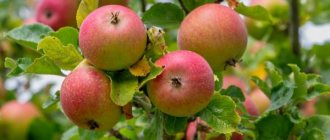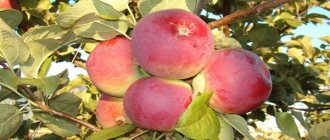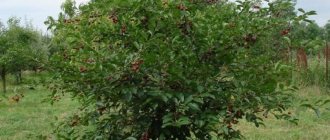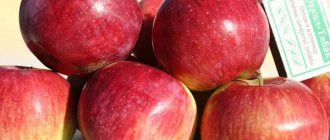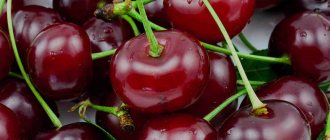We are familiar modest and unpretentious tree in a summer cottage, covered in a cloud of fragrant flowers in spring. It's nice to go out to your garden in the fall and pick fruits from this tree full of vitamins. Yes, we are talking about a ranetka.
The beauty and benefits of the apple tree ranetka can hardly be overestimated. You can feast on apples with northern sourness every year if you plant a seedling on your site. Simple recommendations in the article will help you decide on a variety suitable for your climatic zone, plant a fruit beauty correctly, get high yields and keep them for the whole winter.
Apple tree Ranetka: description of popular varieties
Ranetka - This is the general name for a number of hybrid apple varieties obtained as a result of selection of apple trees popular in Europe with the frost-resistant apple variety Siberian Berry. The result of crossing was the undersized apple trees, which are excellent for the harsh climate, and are distinguished by high yields.
Unfortunately, the taste and appearance of these apples do not allow them to be classified as elite varieties, they are small and, as a rule, sour and tart. You can make various jams, jams and compotes from them, but you won't be able to put them on the table effectively. But apple trees of these varieties can survive both winter frosts and unexpected spring frosts, and this is their main advantage. It can be said without exaggeration that Ranetki are apple trees for Siberia and the Far East.
This variety of ranetka, owing its appearance to Krasnoyarsk breeders, is distinguished by its high yield (up to 50 kg of fruits can be harvested from one tree during the season) and, like all representatives of the species, high winter hardiness. Among other advantages of Dobrynya, it should be mentioned that this apple tree is practically not affected by scab, in addition, it tolerates drought well and grows well.
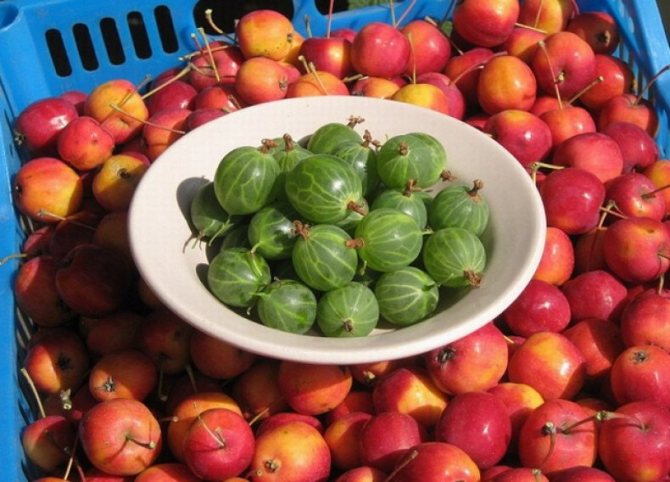
Dobrynya gives its first harvest at the age of four; fruits ripen in early September. Apples of this sort of ranetka have a rather long shelf life - if the necessary conditions are met, they can retain their qualities until the end of winter.
The disadvantages of the variety include the fact that the tree demonstrates high yield rates inconsistently: once every three years, the apple tree "rests".
Dobrynya's fruits have a slightly flattened shape, ribbed, the skin color is almost uniformly purple, the pulp is green, sometimes with red veins. These apples are very juicy and dense, however, they have a sour tart taste and very small sizes (their weight is slightly more than 10 g), therefore, they are used primarily as raw materials for processing. Most of the juice is squeezed out of Dobrynya.
Apple tree Long, perhaps most similar in description to the fabulous paradise apple trees: a small tree with a wide crown, abundantly covered along the entire length of numerous branches with large white flowers, and later - small bright red or red-yellow apples.
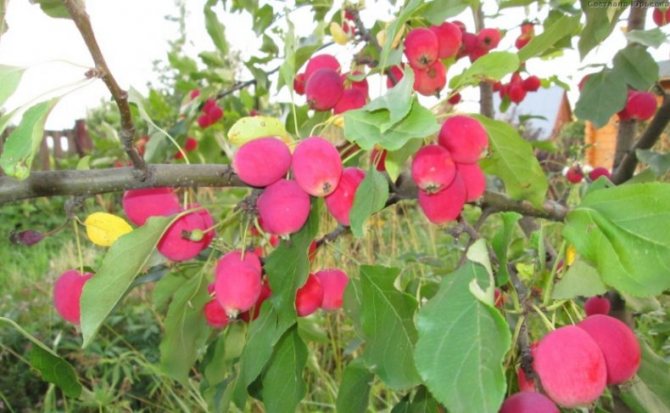

This variety was bred in America in 1917, but the Russian Sibirka was the basis for selection. In Russia, this variety is also called Kitayka, as well as the Plum apple tree, since its leaves are similar to plum trees, and the small fruits elongated in the form of an egg also resemble plums. The variety also got its main name for the long, "long" shape of the fruit.
The apple tree does not grow more than five meters in height for a long time.The branches of the tree are straight, the tips look up.
The fruits, like other ranetki, are small, the mass of apples is usually 11-16 grams (there are, however, Dolgo apple species, which have larger fruits). The skin is smooth, red with a blue bloom. The apple pulp has a creamy color, which subsequently turns yellow, and a dense structure that becomes soft and friable over time.
The main disadvantage of apples is Long - very short shelf life.
You can enjoy them only a few weeks after harvesting (in a cold and dark place, the fruits can be stored for a maximum of two months), therefore the main purpose of this variety is technical processing.
Apple harvest ripens for a long time in late summer - early autumn. The first fruiting of the tree begins at the age of three, the yield is abundant, but not regular. During the season, one apple tree gives an average of 175 kg of fruits, but under favorable conditions, this result can be increased by a quarter.
Apple trees For a long time, due to their high frost resistance and unpretentiousness, they can be grown in regions where gardening practically does not develop. Although this apple tree is not a champion in winter hardiness among other ranetki, it recovers well in case of freezing.
Ranetka Zolotaya is one of the most winter-hardy varieties of apple trees, it is also popular due to its very high yield.
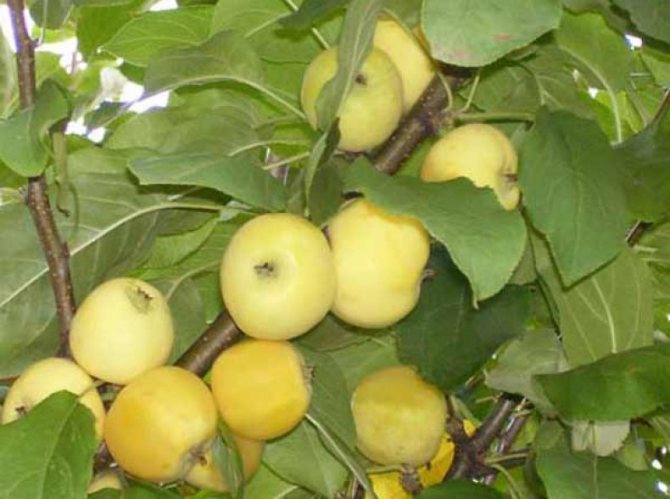

It is a strong and hardy tree, reaching seven meters in height.
The fruiting period begins at three to four years and is stable. From one tree it is usually possible to collect up to half a centner of small (only 5-7 cm) fruits weighing 10-15 g. Depending on the climate, the harvest ripens from July to September. A characteristic feature of this tree is that the apples are mostly tied on the upper half of the branches, pulling them to the ground, due to which the apple tree acquires a very decorative weeping appearance.
Apples have a golden skin color and yellow juicy flesh. The taste is usually sour and tart, but it can also be sweet and sour. They are mainly used for processing.
Like the previous variety, Zolotoy ranetka apples are very poorly stored, in addition, they tend to crumble strongly, and therefore cannot be delayed with harvesting. Another disadvantage of the variety is its poor scab resistance.
Ranetka Krasnaya is another variety of perishable small apples used primarily for juicing and puréing.
This tree begins to harvest very early, sometimes as early as the next year after planting. The regularity of fruiting is fairly stable. Apples ripen in the last decade of August - early September.
The skin of the fruit of this tree, as the name suggests, is dark red, ribbed, the flesh is creamy, juicy and starchy. The apples are almost a regular ball in shape. The taste of Ranetka Red apples is quite good, sourish, with noticeable astringency.
This variety does not stand out with a particularly high winter hardiness among other ranetki.
Laletino is not a very common variety of ranetki. Outwardly, it is a small tree, the crown is round, not too dense.
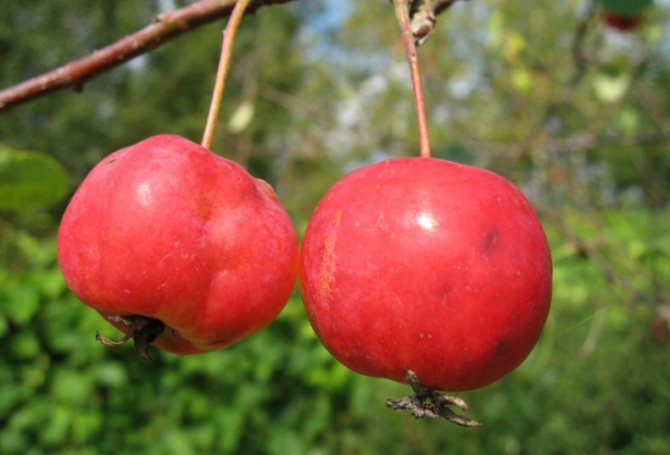

The advantage of the Laletino apple tree is the early fruiting period - at the age of 2-3 years, the tree already yields a harvest. True, after each fruitful year, Laletino usually "rests" during the next year. The fruits ripen by early September.
The apples are small, flat ribbed in shape. The skin is red, almost monochromatic, the flesh is pink, dense and juicy, crispy, sweet and sour in taste.
Ranetka Raspberry is a very winter-hardy representative of the species.
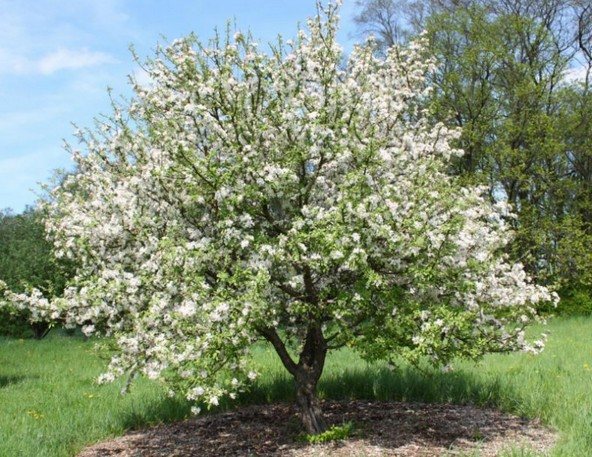

Differs in the early age of the beginning of fruiting (about the third year after planting), high and stable yield. Apples ripen in the first half of September.
The fruits of this apple tree are small even for ranetki, less than 10 g, similar in shape to a plum.The variety owes its name to the color of the apple skins; its characteristic feature is also a pronounced bluish bloom. The pulp is juicy, dense, pink in color and sweet and sour taste. Apples do not differ in high taste and are used as raw materials for the preparation of various preparations.
The dignity of these apples can only be called long shelf life.
In a cool place, the Raspberry Ranetka can lie without spoiling until spring.
Read also: Apple tree Idared: description of the variety with photos, reviews
Features of ripening and fruiting
The beginning of fruiting
Most varieties in the second year bear the first fruits.
Flowering period
Ranetki bloom begins late May or early June... It depends on the variety and favorable weather conditions. Flowering lasts up to 10 days.
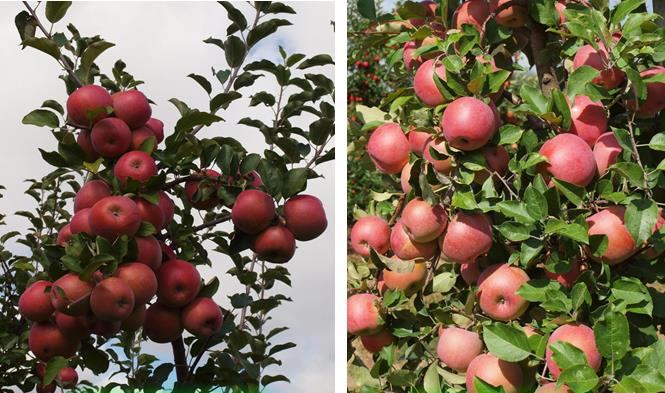

Flowering ranetka.
Timing
Ripening in the northwest
Fruit ripening depends on the variety and weather conditions. For most varieties, the harvest falls on August and September... In late varieties, apples are ready for harvest in October.
Fruit storage
Most varieties of apple ranetka have long shelf life.
They retain all useful qualities and their presentation until the next new year, i.e. until January-February.
In a dry and cool place, apples with stalks hibernate in wooden boxes at temperatures from 0 to 2 degrees, spread out in a thin layer.
Advice! Some varieties are kept frozen.
Purple
Among all ranetki, it is Purpurovaya that is the most winter-hardy variety. It is also less susceptible to spring sunburn than others and, like other representatives of the species, is distinguished by abundant productivity.
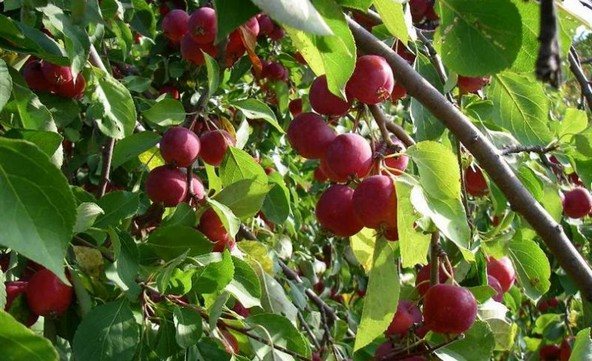

Fruiting at the tree occurs at the age of two to three years. Harvesting takes place at the beginning of September. Up to a centner of apples can be harvested from one tree in a productive year, however, high fruiting is not stable, the periodicity begins to manifest itself especially strongly with age.
The purple ranetka is a fairly powerful tree of medium height. His life span is thirty years or more.
Fruits are small (about 9 g), slightly flattened. The skin is red, monochromatic, the pulp is juicy, of medium density, the color is cream. Apples have a sourish tart taste characteristic of the ranetki, which makes it possible to use them, first of all, in processed form. In addition, the fruits are very poorly stored (maximum - two months).
The apple tree Sibiryachka (the modern name is the Beauty of the Steppe) is similar in description to other varieties of ranetki.
Fruiting of the tree begins from the third or fourth year. The yield is not as high as that of other ranetki, but in terms of winter hardiness, the tree is not inferior to its relatives. The Siberian woman is practically not susceptible to diseases, in particular, scab.
Apples are relatively large (sometimes up to 20 g), have the shape of a ball, slightly flattened horizontally, with a small funnel. The skin of the fruit has two colors - yellow main and red integumentary. The pulp is creamy, juicy, sweet and sour to taste. With a lack of moisture during the ripening period, a bitter note appears in the taste of apples.
The harvest of Sibiryachka ripens in late summer and can be stored for up to three months, subject to the necessary conditions (dark cool rooms).
From other ranetki Sibiryachka can be distinguished by the high amount of juice contained in its fruits. Like other members of the species, these apples are mainly used for processing, in mashed potatoes and juices they are often mixed with carrots and pumpkin.
This rather popular medium-sized variety of ranetka is the result of the labors of Krasnoyarsk breeders.
The tree is narrow, pyramidal, not too dense. The harvest ripens in early September.The fruiting period begins at the age of three, the yield of a young tree is quite stable, but strong fluctuations begin with age. From one tree per season under average conditions, you can get up to 20 kg of fruit.
The apples are small, on average 15 g, oval (hence the name), smooth with a bloom. The skin has a bright raspberry color, which becomes more intense during storage. The pulp is yellowish-pink, with red veins, not very dense, but extremely juicy. The taste of apples is sweet and sour, the aroma is almost not felt.
The advantage of apples is that they do not have the property of falling off the tree and are rather well transported. However, they can be stored for no more than two months.
Apples of the "Lanarik" variety contain a very large amount of ascorbic acid and have excellent qualities in canning, due to which they are widely used in the food industry for the preparation of juices and purees, as well as other preparations. They can also be used fresh.
The flashlight is an exceptionally winter-hardy variety of ranetki. The tree is able to withstand a drop in temperatures below forty degrees, and even with frosts during the flowering period, almost half of the harvest is preserved. This apple tree also recovers well after freezing and is not affected by scab. However, it tolerates drought worse than cold.
Ranetka Amber, due to its origin, is also called Altai.
It is a wide, tall and very dense pyramidal tree. Life expectancy is up to 30 years, fruiting begins in the third year and is characterized by abundance and stability.
Apples ripen in the first half of September, the harvest time is about a month.
Amber fruit weight does not exceed 10 g. Apples have the shape of a ball, ribbed, the skin color is yellow. The pulp is also yellow, firm and juicy.
The taste of apples is not too high, they contain acid and astringency, which is common for ranetki. They are mainly used as raw material for making juices, compotes, jams.
Amber is a winter-hardy apple variety. However, unlike other ranetki, this variety is not resistant to various diseases, mainly the apple tree suffers from scab, fruit rot and ermine moth.
Ranetki are frost-resistant and absolutely unpretentious apple trees.
They can be grown in climates unsuitable for gardening with cold winters, and also used as a rootstock for less hardy apple trees.
The nutritional value
Fruits of various varieties can be used both fresh and for processing. Many gardeners know that some types of ranetki are successfully used to create rootstocks.
The results of biochemical studies of the fruits have confirmed that apples of this type contain almost ten times more biological active substances:
- the content of soluble solids can be up to twenty-five percent;
- in the composition of a significant amount of sugars, represented by fructose and glucose, the amount of which reaches twelve percent;
- the content of pectin substances is at least one and a half percent.


It should be remembered that the merit of pectins is the removal of salts of heavy metals from the human body, as well as radionuclides. Pectins are an excellent natural hemostatic agent that helps in the healing of stomach ulcers, and also have pronounced antimicrobial properties.
General information
"Ranetka" is a common name for several small-fruited apple trees that appeared when crossing the Siberian berry apple and European varieties, as well as the Siberian berry and slate apple, also called "Chinese". The result is trees with high winter hardiness, increased productivity and good resistance to sunburn.
The apple variety has received a large number of characteristics from the Siberian berry (“Siberian”). Trees adapt to most climatic conditions, while there are certain types of "ranetki", which are zoned for the Urals, Altai and the Far East.
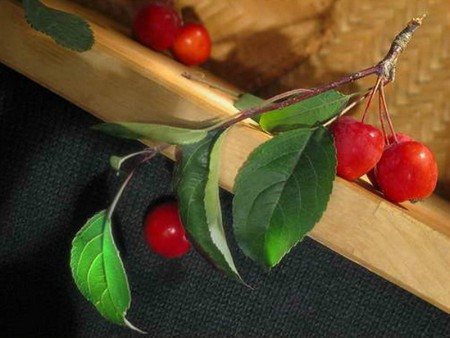

Growing in regions
Due to the fact that one of the ancestors of Ranetki is a variety resistant to low temperatures, the apple tree feels comfortable even in the most extreme conditions. The apple tree is grown in the Urals, Altai, the Far East, in the Krasnoyarsk and Novosibirsk regions.
But this does not mean at all that other regions for cultivation will not be suitable. Europe, Belarus, Ukraine and other regions abroad are quite suitable for planting various types of Ranetki. Moreover, there are special zoned subspecies that are adapted to climate change.
Description and characteristics
As noted above, "Ranetka" is not one apple variety, but a collective name for several hybrids. The following is a description of the most popular species that have won the love of gardeners in all parts of the country.
One of the first ones worth noting is the Dobrynya variety, which received high winter hardiness and vigorous growth from the Siberian. The trees are good scab tolerant, moderate drought tolerance. The early maturity is average, the first harvest can be obtained as early as 4 years of growing a tree in the garden, removing up to 50 kilograms of apples from one tree. However, the harvest is cyclical - every 3-4 years it decreases slightly. On the branches, fruits weighing up to 14 grams are formed, one-dimensional, flattened, with a pronounced ribbing. The peel is dark purple with a slight waxy bloom. The pulp is slightly greenish, dense, juicy, with a pronounced sweet and sour taste and tinges of astringency. The fruits ripen by the beginning of September, and the marketable quality of apples can be preserved until mid-February.


The apple variety “Dolgo” is distinguished by its average height of trees and rather good resistance to low temperatures. The trees enter the fruiting phase at 4-5 years of growth in the garden. Usually they bear fruit at an average level - up to 25 kilograms of apples from each tree. Like almost all Siberian hybrids, the Dolgo variety is resistant to scab. The fruits are relatively large, weighing up to 13 grams, oval in shape, with a rich purple peel and a weakly expressed waxy bloom. The flesh of apples is white, permeated with many red veins, juicy, with a persistent and strong aroma, sweet and sour taste. Apples ripen by the beginning of September, but their marketable quality can be preserved for a maximum of 2 months.
“Ranetka Krasnaya” is another apple variety with small apples weighing up to 9 grams. Apples have an even purple color, cream-colored flesh, very juicy and sour, with distinct tart notes. The apple tree has good winter hardiness and growth duration. The harvest "Red" ripens in early September. The fruits are often used for making juices and purees. However, this variety cannot be kept for more than 2 months either.
Read also: Description of different varieties of apples
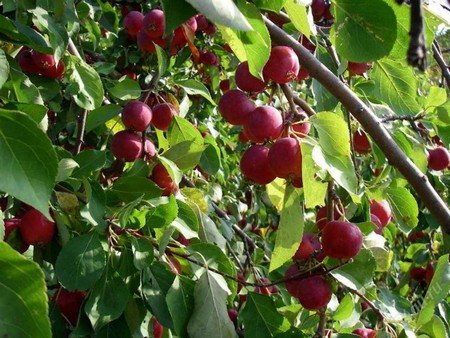

Variety "Ranetka Zolotaya" refers to the columnar apple trees that bear fruit in the second year of growth in your garden. The trees are medium-sized, bear small yellow fruits with a blush on the side facing the sun. However, over time, they completely turn yellow, fully justifying the name, which received the variety "Gold". The pulp of the fruit is white, with a slight yellowish tinge, juicy and sweet, with a subtle astringency. Apples ripen by the beginning of September, and the harvest is relatively stable from year to year.
The "Raspberry" variety also deserves a detailed description, since it is characterized by high winter hardiness and early maturity - the first crop can be harvested two years after planting. It is characterized by stable fruiting, although apples grow up to 6 grams in weight.In the ripening phase, the fruits are round, slightly conical in shape with a dark raspberry peel and a bluish bloom. The pulp is juicy, slightly pinkish, sweet and sour. Apples are good keeping quality. They ripen in early September, and after harvesting, they can be stored for up to 6 months.
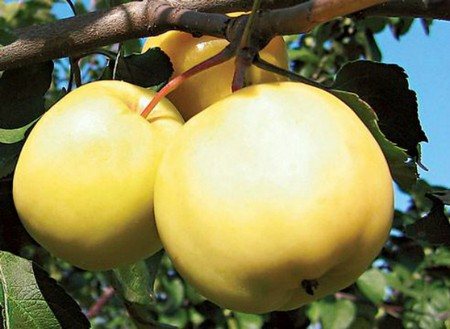

The Yantarnaya variety, better known as Yantarka Altayskaya, is distinguished not only by its high winter hardiness, but also by its longevity. The trees grow tall, bear fruit already for 4 years in the garden, which is most important - they are distinguished by stable and high fruiting. Fruits ripen, weighing up to 10 grams, spherical, ribbed with a light yellow skin. The flesh of the apples is yellow, very juicy, but the taste is sour with hints of astringency.
Often "ranetki" are distinguished by a dense, pyramidal crown, strong trees. But at the same time, they are extremely susceptible to scab and moniliosis, they regularly become a haven for apple moths. Gardeners love these apple trees for their decorative appearance, and their fruits for their high content of nutrients, which is several times higher than the chemical composition of ordinary apples.
Useful properties of apples and contraindications
Due to their affinity with the wild apple tree, which grew in harsh Siberia, Ranetki contain a large amount of nutrients necessary to support health and well-being. Special enzymes present in apple pulp strengthen immunity, normalize water-salt balance and stimulate metabolic processes in the human body.
Chemical composition
Miniature fruits have an unusual taste and bright aroma due to the combination of high molecular weight carbohydrates, essential amino acids and essential fiber. 100 grams of apples contain:
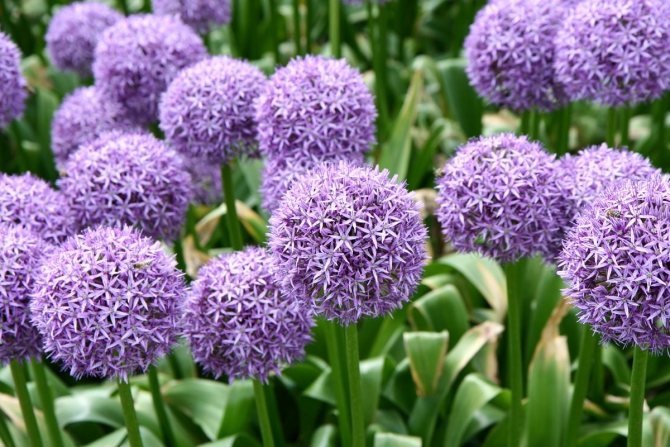

fat - 0.3 grams;- proteins - 0.4 grams;
- organic acids - 0.7 grams;
- carbohydrates - 10 grams;
- ash - 0.4 grams;
- vegetable fiber - 1.9 grams;
- water - 86.5 grams.
The composition of useful fruits also includes vitamins, minerals and chemical components necessary for the normal functioning of all organs and systems:
- essential amino acids (tryptophan, lysine, arginine, methionine, phenylalanine);
- digestible carbohydrates (glucose, fructose, starch, sucrose);
- nonessential amino acids (alanine, glycine, serine, cysteine, glutamic acid);
- vitamins (B1, A, K, C, E, B6, H, B2, B9);
- macronutrients (phosphorus, chlorine, magnesium, calcium, sodium, potassium, sulfur);
- trace elements (iron, chromium, iodine, zinc, manganese, copper, fluorine, aluminum, boron, cobalt).
Unique apple variety Golden Delicious
The substances contained in the pulp of the fruit help break down fat in the human body, speed up metabolism, improve the appearance of the skin, hair, teeth. And also tart apples have a beneficial effect on the state of blood vessels, making them more elastic, helping to fight viral, colds and infectious diseases.
Advantages and disadvantages of fruits
Due to the vitamin composition, ranetki are able to have a beneficial effect on the health of children and adults. Their regular use can affect the body in the following ways:
- The work of the heart is stabilized, the vessels are cleared of cholesterol deposits, they become stronger and stronger.
- The activity of the digestive system is normalized, toxic and harmful substances are removed.
- Working capacity improves, thought processes are activated.
- The metabolism is accelerated, which contributes to the disappearance of extra pounds.
- Blood pressure returns to normal.
- The work of the liver is stabilized, the risk of diseases of the duodenum is reduced.
- Bone tissue is strengthened, the condition of the skin and mucous membranes improves.
Healthy fruits contain tannic compounds, which have a positive effect on the appearance, cheer up and tone the whole body. And thanks to the high content of vitamins, apples help in the fight against vitamin deficiencies and improve visual acuity.
Unfortunately, from excessive use of ranetki or with individual intolerance to fruits, unpleasant symptoms of this nature may occur:
- Allergy.
- Violation of urination.
- Gastritis.
- Increased sensitivity of tooth enamel.
- Colitis, diarrhea.
- Epileptic seizures.
A painful reaction can occur only in people who initially have health problems, therefore, before introducing fruits into your diet, you should consult with your doctor and make sure they are harmless.
Planting and leaving
Description of the planting site for "ranetki" apple trees is not much different from the choice of a site for planting any apple tree. It is desirable that the groundwater does not lie too close to the surface of the earth, the site itself is well lit and not too windy.
Pits for planting are dug up to 90 centimeters deep, the width varies from the size of the roots. There should be at least 70 centimeters of distance between the apple trees, and the row spacing should be 1-1.5 meters. The bottom of the pit is filled with a mixture of humus, soil, ammonium nitrate, potassium and superphosphate. Before planting, the roots of the seedling are carefully straightened, the earth around it is carefully tamped, and then the hole is well watered.
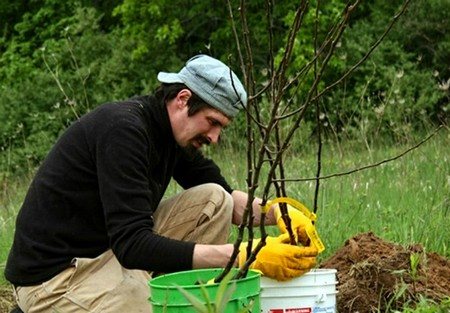

Every spring, it is necessary to treat apple trees with fungicides and insecticides of complex action in order to protect against the development of diseases. Of course, most varieties are resistant to scab or powdery mildew, but prevention strengthens the immunity of trees and helps to preserve the crop at the proper level.
Carefully read the description of tree treatment products before use!
Check tree branches annually and carefully and remove old, dead or frozen ones to help the tree develop better and faster.
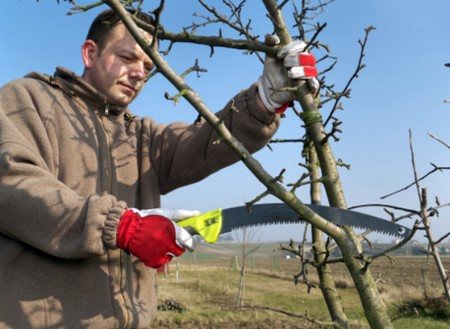

How to plant Ranetka on the site
Planting apple trees does not imply any special nuances; agricultural technology is standard for all crops. The place should be sunny, protected from drafts. It is advisable to place apple trees away from buildings that are thickened with plots of trees so that there is no shade. Ranetki love soil fertile, but not too acidic. The balance is normalized by adding ash, dolomite flour. Groundwater must flow at least 2 meters from the surface, or the ground must be drained.
See also
Description of the Medunitsa apple tree, planting and caring for summer and winter views
To read
Timing
Apple trees are best planted in March, before budding. Sometimes you can engage in planting work in the fall, after leaf fall.
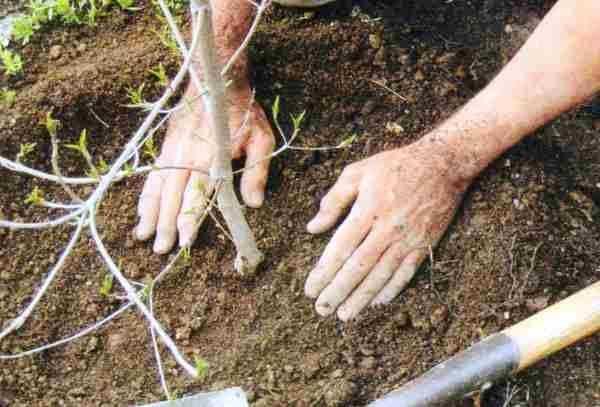

Saplings placement scheme
Seedlings should be planted according to the 5 * 5 scheme, due to the overall dimensions of the bushes. The distance for medium-tall trees should be 4 meters, between strong-growing apple trees, the optimal distance is 5 meters, for dwarf trees - 3 meters. Dig holes 80 cm wide and deep.
Site preparation
Holes are prepared a week before disembarkation. The soil is loosened, weeds are removed. Humus, peat, ash and superphosphate are introduced into the ground.
Tree planting technology
To successfully plant a fruit tree, follow the tips below.
- Dig a hole 80 * 80 * 80. Drive in a peg 1.5 meters high in the middle.
- Straighten the seedlings' rhizomes, lower them into the prepared place.
- Sprinkle the pits with soil so that the root collar remains 5 cm above the surface, tamp.
- Place 2-3 buckets of water under each seedling.
So that young trees develop safely, but the bottom is laid with nutritious compounds. You can use humus. Tie a young seedling to a peg so that it grows evenly.


Disease and pest control
Despite the fact that "ranetki" are quite resistant to fungal diseases and attacks of most pests, their description does not hurt. After all, he who is forewarned is armed.
First of all, the apple moth should be noted. These are small butterflies with a wingspan of 2 centimeters.Butterfly caterpillars overwinter in the bark of branches and fallen leaves. After it gets warm outside, they get out of hiding places and begin to actively eat the buds and young leaves of apple trees. Over time, the caterpillars braid the leaves and separate areas of the bark with cobwebs, in which they subsequently pupate. A new generation of moths emerge from the pupae, which continues to eat the green part of the tree, and then lays eggs.
To get rid of the invasion of the apple moth, it is necessary to spray the trees with Antio, Gardon or Metaphos every spring and autumn, and also to collect and burn the cobwebs that the caterpillars weave.
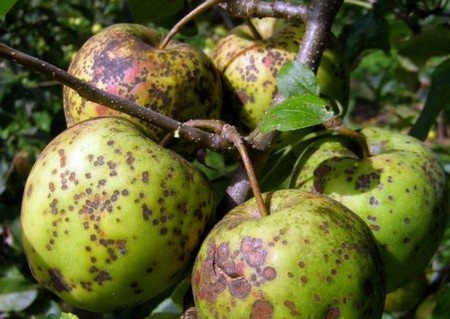

Moniliosis as a disease manifests itself in the form of fruit rot or monilial burn. Fruit rot is a fungal disease that primarily affects the fruits of plants, which then become unusable. The first symptoms of the disease are small brown spots that quickly grow over the entire plane of the fetus. In the center of the spot, gray conidial pads develop. They ripen quickly and by the 10th day, spores from conidia begin to spread to neighboring fruits and plants. Monilial burn often affects plants in the southern regions, but often rampant in the Far East. Infected buds, leaves, fruit twigs, spears and ringlets turn brown and dry out.
As a fight against moniliosis, fungicidal preparations of complex action are used: "Horus", "Strobi", "Gamair".
Scab is another fungal disease. Often it appears as light spots on young leaves, which over time become covered with an olive-brown bloom, and then turn black. The diseased parts of the tree gradually wither, dry out, and then die off. The first step is to rip off the infected parts and incinerate them. The trees must be sprayed with the Zircon preparation, and the soil in the trunk circle must be dug up and watered with 10% ammonium nitrate solution.
Apple tree care
The disease resistance of most Ranetki species is well known, but additional protection against infections and insects will still interfere. For example, before the start of sap flow, you can make a primary spraying with a urea solution, which will scare off pests hibernating under the bark. Also, with the onset of summer, the tree can be treated with a Bordeaux mixture, and the bark in places where it has cracked can be covered with a solution of copper sulfate or garden varnish. But by all means, processing should be carried out before fruiting, otherwise chemistry can get on the crop, which is highly undesirable.
Characteristics of the Ranetka apple tree: photo description
"Ranetka", "Chinese", "Siberian", "heavenly apple" - the names are different, but the variety is one. Breeders are working on breeding clones - today there are more than 10 thousand subspecies in the world. Each subspecies has similar characteristics and distinctive features. The "Paradise Apple Tree" is recognizable by its small fruits. Other characteristics of the variety will be discussed below.
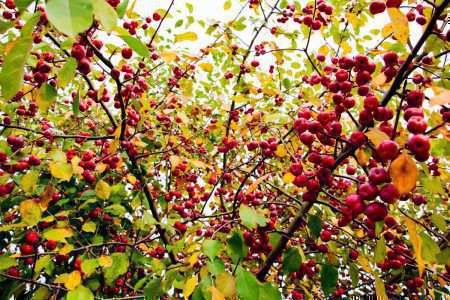

The "Ranetka" variety is recognizable by its small fruits
Advantages and disadvantages
The Ranetka variety has many advantages. It is characterized by:
- high frost resistance;
- rich harvests;
- unpretentiousness in growing and care;
- amicable ripening of crops;
- storage duration for most varieties;
- beneficial properties for health, in particular, the ability to remove heavy metals and toxic substances from the body, as well as increase immunity, due to the high content of vitamin C.
The disadvantages are:
- sour taste of apples;
- their small size;
- massiveness of trees;
- the vulnerability of many species to disease.


Description and photo of the Ranetka apple tree
When choosing seedlings for a personal plot, the gardener focuses on the description of each of them, a photo of the plant during the flowering and fruiting period, as well as on the winter hardiness indicators. After all, fruit trees that adapt well in a temperate climate are not always suitable for cultivation in Siberia and the Urals.Frost resistance is an indicator that is incorporated into the variety at the genetic level. It can be improved in one way - by breeding new hybrids.
Of the 10,000 subspecies of small-fruited apple trees, only a few are able to withstand severe winters and are suitable for growing in regions with difficult climatic conditions. These plants have a protective gene, the structure and reproduction of the apple tree have been changed. One of these varieties is Ranetka and its subspecies.
Video: Grafting an apple tree on the wild
The young plant develops well, grows quickly.
- Agrotechnics
To preserve moisture in the soil, to prevent the reproduction of pest larvae, the root circle is mulched. For these purposes, choose dry land, grass, hay, sawdust. Young seedlings must be tied up. In the spring, the trunks are treated with lime, preventing diseases, insect pests.
- Top dressing
Ranetki grow on any soil, but regular feeding should be present if the ground consists entirely of sand, clay, and has an acidic composition. As a top dressing, wood ash, potassium sulfate, superphosphate, humus are chosen. Too frequent feeding is not required. It is enough to fertilize the soil twice during the growing season.
- Pruning
In the second year of growth, the culture begins to form the crown. Twigs located at an acute angle in relation to the trunk are removed.
Description of the tree
The variety is obtained by crossing a Chinese apple tree with a Siberian small-fruited apple tree. Hence the alternative names of the plant. The fruit tree grows intensively, the branches form a powerful skeleton of the crown. The crown of the plant is wide, oval in shape. The apple tree enters the reproductive phase 3 years after planting a seedling in open ground. The fruits ripen every year, but their numbers change.
Read also: Bashkir beauty (apple tree): description of the variety and reviews of gardeners
A general description of this type of apple tree includes 3 main advantages:
- They tolerate critical temperatures well - 30-40 degrees below 0.
- They do not require special conditions of detention.
- They have good immunity to scab and other diseases.


"Paradise apples" have a sour taste
The photo shows that the paradise apples are small, weighing 12-14 grams. They have a sour and very intense taste, a persistent aroma. Fruits ripen in early September, but are not stored for long - 1-1.5 months. There is one more feature - this variety does not cause allergies, therefore, baby food manufacturers use these apples as raw materials. They are also in demand among winemakers.
Subspecies "Ranetki"
Breeders are experimenting by crossing the Siberian small-fruited apple tree with other types of fruit trees. This is how several subspecies appeared - all of them are classified as the "Ranetka" variety. Popular with gardeners are:
- Dobrynya.
- Long.
- Ranetki purple, red, crimson, amber.
- Change.
And now in detail about each of the listed subspecies.
The Dobrynya variety is characterized by intensive growth and high winter hardiness.
The apple tree begins to bear fruit later than other species - 4 years after planting in the ground. It tolerates drought moderately, but it is famous for its high immunity to scab. The plant bears fruit abundantly, gardeners collect 30-50 kg of fruits from one trunk.
There is a curious pattern: for three years the tree gives a bountiful harvest, in the fourth - the number of fruits decreases significantly. Then the three-year yield cycle is repeated. The fruits are small, weighing 12-14 grams, the shape of the apples is the same - flat ribbed. The color of the fruit is purple, a waxy bloom is visible on the skin. The pulp of Dobrynya apples has a greenish tint, it is dense and juicy.
The taste of the fruit is sweet and sour, with a pleasant astringency in the aftertaste. Apples ripen in early September and are stored until February. They can be frozen - after thawing, the pulp retains its taste and juiciness. Often the fruits of this variety are used as raw materials for the production of natural juices on an industrial scale.
Variety "Dolgo" has average winter hardiness, growth of average intensity. The tree begins to bear fruit 3-4 years after planting. The fruits ripen in early September. They are stored for a month after harvesting. The apples are oval in shape, with juicy white flesh, red streaks appear in places.


Apple variety "Long" has average winter hardiness
They taste more sweet - acid is felt in the aftertaste. The fruits can be eaten fresh or used as raw materials for juices and compotes. One apple tree gives 25 kg of harvest, but it bears fruit consistently every year.
Ranetka purple
"Ranetka purple" is a winter-hardy variety suitable for breeding in regions with a harsh climate. Its growth rate is average, but the apple tree begins to bear fruit earlier than other species - 2-3 years after planting. Fruits are small, the weight of one is 7-8 grams. The apples are shaped like a purple turnip. The purple shell covers the outer surface of the skin in a continuous layer - there are no stripes or shades. The apples are juicy and tart on the palate.
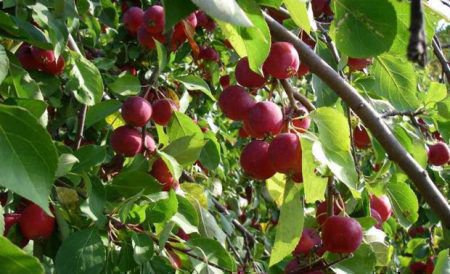

"Ranetka Purple" refers to a winter-hardy variety, the fruits ripen in September
They ripen in early September and are stored until early November. Fresh fruits are not eaten - they are processed into juices and purees. The advantages of the variety are scab immunity and abundant fruiting. Up to 100 kg of harvest is harvested from one tree. The photo of apple trees of this variety shows how tightly the fruits cover the branches.
Ranetka red
The "Ranetka Krasnaya" variety was bred by the Annunciation breeders headed by A. Efremov. The characteristics of the plant are average, but one of the main advantages is early fruiting - from the second year. Gardeners collect 50-60 kg of fruit from one tree. They ripen at the end of August. The apples are spherical, the ribbing is pronounced.


The fruits of the "Ranetka Krasnaya" variety ripen at the end of August
The skin is of medium density, red in color, which fully justifies the name. The apple weighs 9-10 grams. There is a lot of juice in the pulp, the taste is sweet and sour. Fresh fruits are rarely consumed - they are often processed into juices and jams.
Ranetka Raspberry


"Raspberry" - a variety that is one of the best subspecies of "Ranetok"
This apple tree is one of the best subspecies of "Ranetok", according to some characteristics it surpasses the variety "Dobrynya":
- The apple tree gives the first harvest in the third year of life.
- Bears fruit in a stable and abundant manner.
- Highly preserved fruits - stored for up to six months after harvest.
- High winter hardiness, suitable for cultivation in northern regions.
- Good scab immunity.
In the photo of Ranetki Raspberry, you can see that her fruits are very small - up to 6 grams. The shape of the apples is round, closer to conical. The skin is painted in a dark raspberry color, on which a bluish bloom appears. The pulp of apples is juicy, pink in color, with a dense consistency. The taste of the fruit is sweet, and acid is also present in it. The crop is harvested on the 15th of September.
Ranetka amber
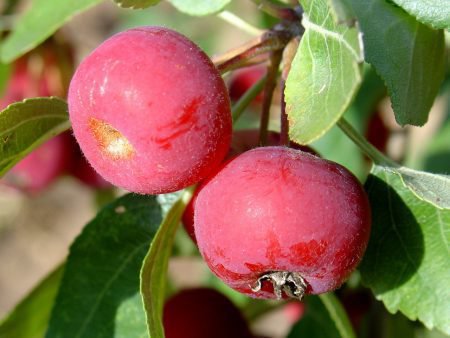

"Yantarnaya" has a high level of frost resistance
The second name of this subspecies is "Ranetka Altai". The benefits of the fruit tree include:
- High winter hardiness.
- Longevity of plants.
- Consistently high yield.
The apple tree bears fruit from 4-5 years, the fruits ripen in early autumn. They are small - no more than 10 grams, abundantly cover the entire crown of a tall tree. The apples are similar in shape to a ball, their skin color is light, closer to amber. Almost the same color and flesh. It is dense with a lot of juice. The taste of apples is sour and tart, so they are not eaten fresh.
The Smena apple tree is a tall tree resistant to severe frosts. The plant enters the reproductive phase in 3-4 years. It cannot boast of a bountiful harvest - 25-30 kg per tree, but it bears fruit stably. Apples are larger than those of other types of "Ranetki" - 10-14 grams each. The shape of the fruit is round, closer to oval.
The sweet and sour taste of the fruit pleasantly refreshes, does not lose its piquancy during storage or after conservation.
The fruits are harvested in the last days of August, and they are stored until mid-November. The apple tree "Smena" is not afraid of scab and other fungal diseases, therefore, caring for it is minimized.
Testimonials
Svetlana Fedorovna: “Wild Ranetka is growing in our country house. It is constantly dotted with small red fruits that taste not very, too tart. But lately we have been collecting them for compote, where they very nicely complement other fruits and berries ”.
Svetlana Nikolaevna: “I planted Honey Ranetka, the taste of small apples is quite pleasant. We collect them for jam in winter, they are very useful. Sometimes I freeze the apples. "
Nikolay Petrovich: “Apple tree Ranetka is unpretentious, which makes me especially happy. You just need to cut the crown so that it does not overgrow too much. Sometimes he gets sick with scab, but rarely. "
Peter Viktorovich: “Green Ranetki look like wood, it tastes terribly sour and tart. But after they are touched by frost, they are even sweetish. But the cider is very tasty. "

